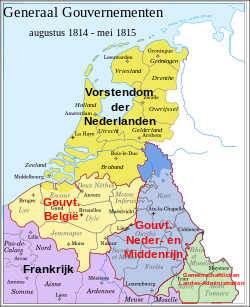Sovereign Principality of the United Netherlands
| Sovereign Principality of the United Netherlands | ||||||||||
| Soeverein Vorstendom der Verenigde Nederlanden | ||||||||||
|
||||||||||
|
||||||||||
|
Motto Je maintiendrai "I will maintain" |
||||||||||
|
Anthem Wilhelmus van Nassouwe "William of Nassau" |
||||||||||
|
The Principality shown in dark yellow
|
||||||||||
| Capital | Amsterdam | |||||||||
| Languages | Dutch | |||||||||
| Religion | Protestant, Catholic | |||||||||
| Government | Principality | |||||||||
| Sovereign Prince | ||||||||||
| • | 1813–1815 | William Frederick | ||||||||
| Legislature | States General | |||||||||
| Historical era | Early Modern | |||||||||
| • | Driemanschap | 20 November 1813 | ||||||||
| • | Constitution adopted | 29 March 1814 | ||||||||
| • | London Protocol | 21 June 1814 | ||||||||
| • | Anglo-Dutch Treaty | 13 August 1814 | ||||||||
| • | Congress of Vienna | 16 March 1815 | ||||||||
| Population | ||||||||||
| • | 1815 est. | 2,233,000 | ||||||||
| Currency | Dutch guilder | |||||||||
|
||||||||||
The Sovereign Principality of the United Netherlands (Dutch: Souvereine Vorstendom der Verëenigde Nederlanden) was a short-lived sovereign principality and the precursor of the United Kingdom of the Netherlands, in which it was reunited with the Southern Netherlands in 1815. The principality was proclaimed in 1813 when the victors of the Napoleonic Wars established a political reorganisation of Europe, which would eventually be defined by the Congress of Vienna.
After the liberation of the Netherlands from France by Prussian and Russian troops in 1813, a provisional government took over the country. It was headed by a triumvirate of three Dutch noblemen, Frans Adam van der Duyn van Maasdam, Leopold of Limburg Stirum and Gijsbert Karel van Hogendorp. This Driemanschap formally took control over the liberated country on 20 November, and declared the Principality of the United Netherlands a day thereafter.
It was taken for granted that any new regime would have to be headed by William Frederick, the son of the last Stadtholder of the Dutch Republic, William V. Although many members of the provisional government had helped drive out William V eighteen years earlier, most of its leading members agreed that it would be better for the Dutch to invite William Frederick themselves rather than have him imposed by the allies. After receiving an invitation from the Driemanschap, William Frederick returned from his exile to England. He disembarked from HMS Warrior and landed at Scheveningen beach on 30 November 1813, and accepted sovereignty over the principality on 2 December, proclaiming himself "Sovereign Prince" of the United Netherlands.
...
Wikipedia



